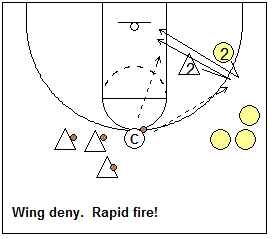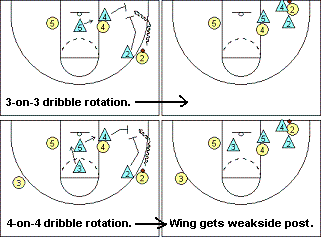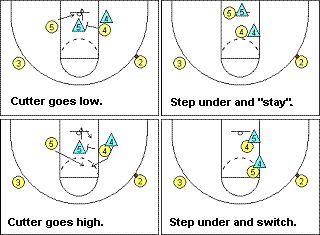1-on-1 DrillAll defenders must learn how to play good 1-on-1, on-ball defense. In this drill, each player has a partner (opponent) that he/she goes 1-on-1 against. Each pair has a ball. Use both ends of the court. The player with the ball starts at the top of the key and tries to make a move, or shoot the outside shot and score on the defender. The defender must stop the offense, box-out and get the rebound. The offense gets a point for (1) each basket made, (2) for each offensive rebound and (3) if the defender fouls. No second shots are allowed. Each pair keeps track of their score. Have post players paired up with post players, and guards paired up with guards. Play until each player gets five offensive possessions. At the end, the losers do 5-10 push-ups.
Rotation (see arrows in the diagram)
After a pair has finished their duel, they get in line on the other end of the floor, but switch offense and defense for the next possession.
This drill is also great for offensive players working on their 1-on-1 moves... jab step, shot fake, dribble moves, etc.
|
 |
Low Post Fronting Drill
When the ball is on the wing, we 1/2 or 3/4 front the low post from the baseline side (and double-team with our opposite wing player). Fronting from the baseline side stops the baseline drop-step move. The defender straddles the post player with one foot behind and one foot in front with one arm wrapped around the front of the post player.|
When the ball is at the point, we then step below
and around, and get both feet above the offensive post with an arm bar
on him/her and a hand in the passing lane. We step under (rather than in
front of the offensive player) because we never give up inside position
this way. If you step in front, it is possible for the offensive player
to seal you and get inside position for the quick inside pass.
See the diagram. Pass the ball back and forth from the
wing to the point. The post defender must quickly re-position with each
pass. You can use both low blocks to teach defense on both sides of the
court. This is a very simple but important drill in teaching correct
fronting and defensive footwork. |
 |
Pass into the Low Post, Double-Team
Sometimes the pass will get into the low post. We double-team this with our post defender on the baseline side (see above drill), and our opposite wing defender (who is already in the paint in helpside) from the lane side. This allows us to keep our opposite post defender on their other "big man".|
This drill stresses helpside positioning of the wing
defenders and double-teaming the low post, and correct 1/2 - 3/4 front
positioning by our low post defender. We start with the ball on the
wing, allow the pass into the post and then set the double-team. The
ball is skipped passed to the opposite wing, the wing defender sprints
out to close-out, the opposite wing slides into helpside and the ball is
passed into the opposite post. Pointer: On the skip pass from the post to the opposite wing, instead of the our helpside wing defender sprinting all the way out to his/her man, we will have our point defender cover this pass and the helpside wing defender jumps out to cover the point guard, who is closer and easier to get to. We call this a defensive "X-cut". You can drill this 5-on-5. |
 |
Post Defense vs Cutter
We want our post defenders to impede or slow-down cutters by getting in the cutter's way and using an "arm bar". We do not grab, elbow or do anything unsportsmanlike here, but simply try to use our strength and footwork to disrupt the cutter's timing or put him/her off the intended path of the cut. This drill also stresses correct helpside positioning when the ball is on the wing, and correct baseline fronting position.
See the diagrams below. Two offensive wing players, one
offensive post and one defensive post are used. Start with the ball on
the wing opposite the offensive post player. The post defender should
now be in helpside with one foot on the helpside line (imaginary
vertical line in the center of the paint). The offensive post player
cuts to the ball-side block. The defensive post tries to impede the
cutter with an arm bar and then 1/2 - 3/4 fronts from the baseline side.
The ball is passed to the opposite wing, the defender moves into
helpside, and the cut and "bump" are repeated going back to the
ball-side.

You can work this drill from both wings. At the start, one post defender should be 1/2 fronting from the baseline side while the other post defender should be in helpside.
Wing Deny Drill
This drill emphasizes denying the pass to the offensive wing player. We want to deny both the pass to the V-cut outside and also deny the pass to the backcutting wing player.| See the diagram. You need a lot of balls for this
drill. Your assistant or a manager makes the rapid fire pass to the wing
V-cutting. The defensive player denies this pass by tipping it away
with his/her right hand (on the right side of the court). Using that
hand allows the defender to still see and stay with his/her man. If the
other hand is used instead (incorrectly) and the deflection is missed,
the defender is easily beaten by the backcut.
After deflecting the pass to the V-cut, the offensive wing
makes the quick backcut toward the hoop and the assistant tries to make
that pass. The defender tries to deflect that pass as well. A good
defender will be able to deflect both the V-cut pass and the backcut
pass. Each rotation features both passes. Players waiting in line can
help supply balls to the passer (assistant).
|
 |
Wing Helpside, Skip-Pass and Close-Out Drill
Our wing players must learn to play correct helpside defense (in the paint) when ball is two passes away on the opposite wing. This will help protect the paint from inside dribble-penetration and passing, and we can also use this helpside wing to double-team the low post (see above). On the other hand, the wing player must also close-out quickly when the ball is skipped-passed back to his/her man. See the diagrams below. Use two offensive and two defensive wing players. The ball is skipped passed back and forth while the defenders work on correct helpside positioning and closing-out. Rotate offense to defense after several passes back and forth. http://www.coachesclipboard.net/M2MDrills.html
http://www.coachesclipboard.net/M2MDrills.html


No comments:
Post a Comment